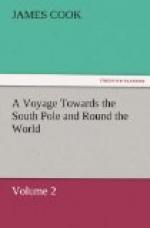At three o’clock we passed Cape Noir, which is a steep rock of considerable height, and the S.W. point of a large island that seemed to lie detached, a league, or a league and a half, from the main land. The land of the cape, when at a distance from it, appeared to be an island disjoined from the other; but, on a nearer approach, we found it connected by a low neck of land. At the point of the cape are two rocks; the one peaked like a sugar- loaf, the other not so high, and shewing a rounder surface; and S. by E., two leagues from the cape, are two other rocky islets. This cape is situated in the latitude of 54 deg. 30’ S., longitude 73 deg. 33’ W.
After passing the two islets, we steered E.S.E., crossing the great bay of St Barbara. We but just saw the land in the bottom of it, which could not be less than seven or eight leagues from us. There was a space, lying in the direction of E.N.E. from Cape Noir, where no land was to be seen: this may be the channel of St Barbara, which opens into the straits of Magalhaens, as mentioned by Frezier. We found the cape to agree very well with his description, which shews that he laid down the channel from good memoirs. At ten o’clock, drawing near the S.E. point of the bay, which, lies nearly in the direction of S. 60 deg. E. from Cape Noir, eighteen leagues distant, we shortened sail, and spent the night standing off and on.
At two o’clock in the morning of the 19th, having made sail, we steered S.E. by E. along the coast, and soon passed the S.E. point of the bay of St Barbara, which I called Cape Desolation, because near it commenced the most desolate and barren country I ever saw. It is situated in the latitude of 54 deg. 55’ S., longitude 72 deg. 12’ W. About four leagues to the east of this cape is a deep inlet, at the entrance of which lies a pretty large island, and some others of less note. Nearly in this situation some charts place a channel leading into the straits of Magalhaens, under the name of straits of Jelouzel. At ten o’clock, being about a league and a half from the land, we sounded, and found sixty fathoms water, a bottom of small stones and shells.
The wind, which had been fresh at N. by W., began to abate, and at noon it fell calm, when we observed in latitude 55 deg. 20’ S., longitude made from Cape Deseada 3 deg. 24’ E. In this situation we were about three leagues from the nearest shore, which was that of an island. This I named Gilbert Isle, after my master. It is nearly of the same height with the rest of the coast, and shews a surface composed of several peaked rocks unequally high. A little to the S.E. of it are some smaller islands, and, without them, breakers.
I have before observed that this is the most desolate coast I ever saw. It seems entirely composed of rocky mountains without the least appearance of vegetation. These mountains terminate in horrible precipices, whose craggy summits spire up to a vast height, so that hardly any thing in nature can appear with a more barren and savage aspect than the whole of this country. The inland mountains were covered with snow, but those on the sea-coast were not. We judged the former to belong to the main of Terra del Fuego, and the latter to be islands, so ranged as apparently to form a coast.




